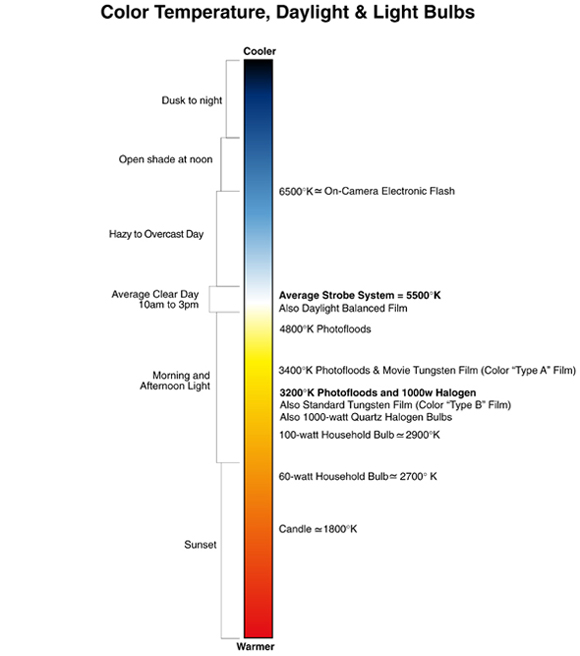

As the day progresses, the light temperature changes. Light temperature is measured in "Kelvin" This chart shows the approximate color temperature for different types of daylight and bulbs. Remember: precise color temperature can vary from moment to moment and even from expert to expert. Plus, light bulbs change colors (become "warmer") as they age. Fortunately, in a vast majority of cases, it is more important to know where a light source is on the color scale than it is to know its precise Kelvin rating.

Color temperature can also be changed in post-processing. As many photographers develop and scan their own film, they can fix the color temperature of a photo through scanning software or in photo editing software such as Adobe Lightroom and Adobe Photoshop. These programs contain color temperature sliders that can dramatically change the image. The best example of this is taking a RAW image into one of the editing programs and adjusting the color temperature in either direction. Your result will look much different from what you originally began with.
Although there are many ways to change color temperature in post-production, it is always best to get it done on set or on location. One way to match the film and light source's color temperature is with on-camera filters. To find the right match use our On-Camera Filters Colors and Effects Chart. These filters change the image as a whole; however, using multiple lights with different color temperatures gives the artist more control over the details of the image. Most photographers and cinematographers today use multi-light set ups. While one light may be daylight balanced and one may be tungsten balanced, this can either produce a more real-life feel or when done to the extreme, can create a split-toned image in camera.
A common way for artists to achieve their desired color temperature is through the use of gels. Gels come in many different colors, but two of the most common gels are CTO (Color Temperature Orange) and CTB (Color Temperature Blue). Gels are a common fix for color temperature when the appropriate temperature light is unavailable. They cover any light source and alter the color temperature of the light. This can be applied to any light, including cell phones, off-camera flashes, ceiling lights, etc. .
To see color temperatures in action, look at these two sample images.